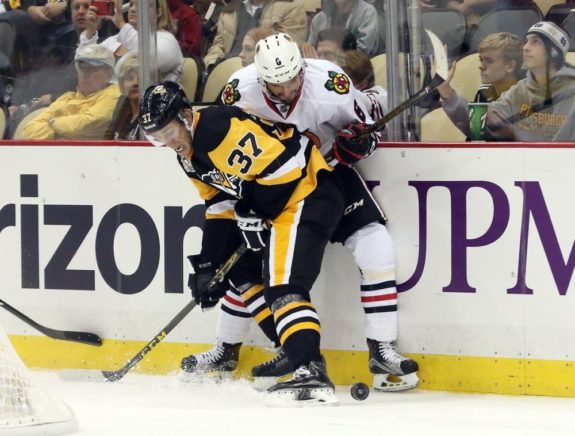Carter Rowney caught some attention in the NHL last night when he helped bring an early end to the season of the St. Louis Blues‘ Robby Fabbri. After the two collided into the boards, a limping Fabbri had to be helped off the ice; the Blues announced later that Fabbri would be out for the rest of the season with a torn ACL.
The Pittsburgh Penguins’ Saturday game against the Blues marked Rowney’s third game played in the NHL. Here’s a checkup on how the 27-year old center’s major league debut is going thus far.

Where Did Carter Rowney Come From?
Rowney has spent stints of time with the Penguins’ minor-league affiliate for the past three seasons, rotating between the ECHL and the AHL until spending all of the 2015-16 season with Wilkes-Barre/Scranton. He’s improved notably in his time in the AHL, going from only four points in 24 games in his first season to an impressive 56 in 74 in the 2015-16 season. That’s an average of about 0.75 points per game. In addition, he scored 12 points in 10 playoff games during the postseason, proving that he could be a clutch player when the time came. Late in that same 2015-2016 season, the Penguins signed Rowney to a two-year, two-way contract.

Now, this season, Rowney had gotten 21 points in 26 games in the AHL when he was called up to play in the NHL. With the Penguins suffering notable injuries in their offensive lineup, including first-line winger Conor Sheary and second-line anchor Evgeni Malkin, the team has been forced to see just how far down their depth goes. Rowney, who has shown he can produce consistently at the AHL level, is an important part of that. The Penguins’ 2016 playoff success was mostly due to their solid rotation of three strong lines. If Rowney can prove to be a strong center for the third line, it will go a long way to maintaining depth in the lineup during the current bout of injuries.
Rowney’s Results
Rowney scored his first NHL point in his third game with the Penguins when he assisted on Kris Letang’s goal against the Blues on Saturday night. The play demonstrated good on-ice awareness. Rowney sighted Letang halfway down the ice, just coming out of the penalty box, and got him the puck for a breakaway play that ended up turning the tide of the game the Penguins’ way.
Saturday’s game was the first game Rowney has finished with a positive plus-minus rating. His performance against the Columbus Blue Jackets the day before had netted him a neutral zero, and in his Jan. 31 debut he finished with a minus-1 rating. Although nowhere close to his fellow Wilkes-Barre/Scranton call-up Jake Guentzel‘s NHL debut, in which Guentzel scored two goals in his first game, Rowney’s introduction to the NHL shows that he could be adapting to the Penguins’ style of play.
Congrats on your first NHL point, @carterrowney! pic.twitter.com/v2gsBgs02v
— Pittsburgh Penguins (@penguins) February 5, 2017
Right now, Rowney is relegated to the Penguins’ third line. Bryan Rust, bumped down from the top line after Sheary’s injury, and Carl Hagelin, moved off what has so far this season been an underwhelming HBK line, flank him on either side. The former HBK line, now functioning as the Penguins’ second line instead of third, is using fellow NHL rookie Guentzel as a right wing in Hagelin’s place.
What to Expect in the Future
Rowney is important for the Penguins in more than one way. He’s important right now as the Penguins deal with injuries that severely undermine the power of their lineup depth (get well soon, Sheary and Malkin). But he’s also important in the future; his cap hit is almost at the league minimum salary at only $612,500, and he’s already signed on through the next season. That’s the smallest cap hit of any forward currently on the Penguins’ roster.
As the trade deadline and expansion draft loom, the Penguins will be eyeing the more inexpensive players on their roster as top choices for high individual production. If they can get Carter Rowney to produce anywhere near his AHL production levels, then he will be hugely helpful to maintaining the depth of the Penguins’ offensive lineup as they absorb the inevitable losses of the trading season and of the current injuries. The Penguins need a solid third line to retain their level of competitiveness.